Marylebone station
| Marylebone | |
|---|---|
| London Marylebone | |
|
Main Entrance | |
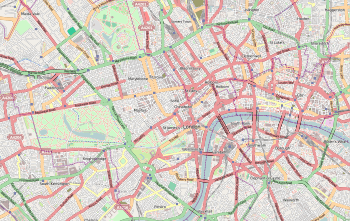 Marylebone Location of Marylebone in Central London | |
| Location | Marylebone |
| Local authority | City of Westminster |
| Managed by | Chiltern Railways |
| Owner | Network Rail |
| Station code | MYB |
| DfT category | A |
| Number of platforms | 6 |
| Accessible | Yes [1] |
| Fare zone | 1 |
| National Rail annual entry and exit | |
| 2010–11 |
|
| 2011–12 |
|
| 2012–13 |
|
| 2013–14 |
|
| 2014–15 |
|
| – interchange | 0.496 million[2] |
| Railway companies | |
| Original company | Great Central Railway |
| Pre-grouping | Great Central Railway |
| Post-grouping | London & North Eastern Railway |
| Key dates | |
| 1899 | Opened |
| 2006 | Two new platforms built |
| Other information | |
| Lists of stations | |
| External links | |
| WGS84 | 51°31′20″N 0°09′48″W / 51.5223°N 0.1634°WCoordinates: 51°31′20″N 0°09′48″W / 51.5223°N 0.1634°W |
|
| |
Marylebone station (![]() i/ˈmɑːrlᵻbən/ MAR-li-bən), also known as London Marylebone,[3] is a central London railway terminus and London Underground station on the Bakerloo line. It is about 1.5 miles from the main line station at Euston and 0.5 miles from Paddington.
i/ˈmɑːrlᵻbən/ MAR-li-bən), also known as London Marylebone,[3] is a central London railway terminus and London Underground station on the Bakerloo line. It is about 1.5 miles from the main line station at Euston and 0.5 miles from Paddington.
Originally the London terminus of the former Great Central Main Line to Sheffield and Manchester, closed north of Aylesbury in 1966, it now serves as the terminus of the Chiltern Main Line route to Birmingham, the London to Aylesbury Line (a remaining part of the former Great Central Line), and, in 2015, services commenced between Marylebone and Oxford Parkway, via a new chord connecting the Chiltern Main Line to the Oxford to Bicester Line. An extension to Oxford is due to open in December 2016.
All services at the station are operated by Chiltern Railways, which provides commuter/regional services in a roughly NW direction, principally along the M40 corridor to destinations in parts of Buckinghamshire, Oxfordshire, Warwickshire and the West Midlands.
Opened in 1899,[4] it is the youngest of London's main line terminal stations, and also one of the smallest, having opened with half the number of platforms originally planned. It is also the only London terminal station to host only diesel trains, having no electrified lines. From 1967 for many years it was served only by diesel multiple-unit trains (DMUs). It now once again also sees locomotive-hauled trains daily.
Marylebone is in Travelcard Zone 1.
Location
The station stands on Melcombe Place just north of Marylebone Road, a straight west-to-east thoroughfare through Marylebone in central London; Baker Street is close by to the east and south east. It is in the northern, Lisson Grove, neighbourhood of the district, in a northern projection of the Bryanston and Dorset Square ward immediately south of St Johns Wood. North-east is Regent's Park, north in a network of mostly residential streets is Lord's Cricket Ground and south, south-west and south-east are a mixed-use network of streets.[5]
London Buses routes 2, 13, 18, 27, 30, 74, 82, 113, 139, 189, 205, 274 and 453 and night routes N13, N18, N74 and N205 serve the station.
National Rail
The main line station has six platforms; two built in 1899, two inserted into the former carriage road in the 1980s, and two built in September 2006. It is the only non-electrified terminal in London. Marylebone is operated by Chiltern Railways (part of Deutsche Bahn AG), making it one of the few London terminal stations not to be managed by Network Rail.[6]
Chiltern Railways operates all services at the station, accessing the Chiltern Main Line and London to Aylesbury Line routes which serve High Wycombe, Aylesbury, Bicester, Banbury, Leamington Spa, Warwick, Solihull, Birmingham Moor Street, Birmingham Snow Hill, and (at peak hours) Stourbridge Junction and Kidderminster. There are services to Oxford Parkway via the Oxford to Bicester Line, and some services to Stratford-upon-Avon via the Leamington to Stratford branch line.
History
GCR and LNER

The early history of Marylebone is tied into the Great Central Railway's Great Central Main Line extension into London. When Sir Edward Watkin became chairman of the Manchester, Sheffield and Lincolnshire Railway in 1864, the line was not particularly lucrative as it had no direct connection to London. Watkin was unhappy about transferring traffic to the Great Northern Railway, and when he became chairman of the Metropolitan Railway in 1872, he decided to build a dedicated line between the MS&LR and Central London.[7]
The approach to Marylebone was the last section of the Great Central Main Line to be built. Progress was delayed in the 1890s because of objections, particularly as the line would pass through Lord's, the principal cricket ground in London and home of Marylebone Cricket Club. Watkin promised that Lord's would not be disrupted by the railway construction, and an Act to complete the line was passed on 28 March 1893.[8] The station was built on a 51-acre (21 ha) site around Blandford and Harewood Squares, west of Regent's Park. More than 4,000 working-class people were evicted from their homes to turn Harewood Avenue and Rossmore Road into approach roads; around 2,600 of them were rehomed in new apartments near St. John's Wood Road. Watkin resigned the chairmanship in 1894 following ill health, and was replaced by Lord Wharncliffe.[9] The approach to the station through Lord's was achieved by a cut and cover tunnel constructed between September 1896 and May 1897, avoiding the cancellation of any cricket.[10]

The station opened to coal traffic on 27 July 1898[11] and to passengers on 15 March 1899.[12][13] It was the terminus of the GCR's London extension main line – the last major railway line to be built into London until High Speed 1.[14] The Great Central Railway linked London to High Wycombe, Aylesbury, Rugby, Leicester, Nottingham, Sheffield and Manchester. Local services from northwest Middlesex, High Wycombe and Aylesbury also terminated at Marylebone.[8] The GCR moved its headquarters to Marylebone from Manchester in 1905.[15]
The station was designed by Henry William Braddock,[16] a civil engineer for the Great Central Railway.[14][17] Owing to the GCR's lack of money, the station's design is simple and modest.[18] The main booking hall was 63 feet (19.2 m) by 40 feet 6 inches (12.3 m).[19] It is a domestic version of the "Wrenaissance" revival style that fits in with the residential surroundings with Dutch gables, employing warm brick and cream-coloured stone.[19] The GCR crest was worked into the wrought iron railings in numerous places.[18]
The original plan was for eight platforms,[20] but half were designated as a "possible future extension".[21] The cost of building the GCR was far higher than expected, nearly bankrupting the company.[21] The line leading to the station cut through 70 acres (28 ha) of middle class housing, including the Eyre Estate in St John's Wood and the area around Lord's, drawing protests and requiring a relocation of the track and station facilities.[22] There was never enough money for the extra platforms, and only four were built, three inside the train shed and one to its west (platform 4).[23] As a result, the concourse is unusually long and had three walls for most of the 20th century. The northern wall was missing, as the GCR anticipated that the other four platforms, under an extended train shed, would be built later on. (This land was later filled with office blocks). The cost of the London Extension meant that the adjoining Great Central Hotel, designed by Sir Robert William Ellis, was built by a different company.[24] The hotel operated for a relatively short time and was converted to offices in 1945, becoming the headquarters of British Rail from 1948 to 1986.[11] The offices were restored as a hotel in 1993.[25]
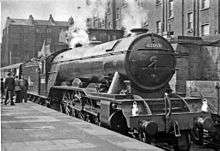
Passenger traffic on the GCR was never heavy because it was the last main line to be built and had difficulty competing against longer-established rivals (especially the Midland Railway from its terminal at St Pancras) for the lucrative intercity passenger business. For 40 miles (64 km) between Aylesbury and Rugby the line traversed thinly-populated countryside, attracting little passenger business at intermediate stations. The GCR also struggled to compete with the Metropolitan Railway for 2nd- and 3rd-class traffic from nearby towns such as Harrow, Chesham and Aylesbury but had the upper hand on 1st-class travel between these towns, being quick, reliable and luxurious compared to the Met. Low passenger traffic meant Marylebone was the quietest and most pleasant of London's termini. In 1903 there were only 14 daily passenger arrivals.[26]
The GCR was unhappy about having to use the Metropolitan Railway to reach Marylebone, and opened a new line to High Wycombe on 2 April 1906. The additional suburban services generated traffic for the station, which had previously been so empty on occasion that the staff outnumbered passengers.[27] While passenger traffic remained relatively sparse, the line was heavily used for freight, especially coal; in 1914, 67% of traffic was goods-related. Trains ran from the north and East Midlands to the freight depot adjoining the station, which was marginally the largest in London.[15]
The heyday of the line was between 1923, when the GCR was absorbed into the London and North Eastern Railway[28][29] and 1948, when the LNER was nationalised to form the British Rail Eastern Region.[29] As a result, many prestigious locomotives, such as Flying Scotsman, Sir Nigel Gresley, and Mallard which ran on the East Coast Main Line, were frequent visitors to the line. Special trains ran on the line to destinations such as Scotland.[30] The station's busiest use came after the construction of Wembley Stadium in 1923, when it was used to contain large crowds wishing to see the FA Cup Final. Special services ran from Marylebone to the British Empire Exhibition at Wembley Park the following year.[28]
Unlike other London terminii, Marylebone saw little direct damage during the Blitz. It was closed between 5 October and 26 November 1940 after the approach tunnels were breached, and the goods depot was bombed on 16 April 1941.[31]
British Rail
After nationalisation in 1948, British Railways attempted to keep Marylebone open as a long-distance station and introduced the Master Cutler service to Sheffield and the South Yorkshireman to Bradford, but they were not well-used.[32] From 1949, all local services towards High Wycombe and Princes Risborough were routed into Marylebone, although the frequency of trains was reduced two years later.[31]
The Great Central Main Line duplicated the route of the Midland Main Line and long-distance trains from Marylebone were scaled back from 1958, leading to the closure of the Great Central Main Line north of Aylesbury on 4 September 1966 in the Beeching Axe.[32]
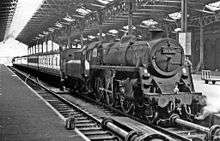
The rundown of services began after the line was transferred from British Railways' Eastern Region to the London Midland Region, although the station and the first few miles of its route had been part of the Western Region from 1950.[33] In 1958, the Master Cutler was diverted to London King's Cross and the East Coast Main Line. In 1960 all express services were discontinued. From then until closure in 1966 only a few daily long-distance "semi-fast" services to Nottingham remained, mainly steam-hauled by LMR 'Black 5s'.[29] In 1965 freight services were curtailed.[29] Marylebone's large goods yard was closed and sold to the Greater London Council for housing.[26] The last long-distance service ran on 4 September 1966, except for a brief reprieve the following year when Paddington was undergoing signal works.[32]
Marylebone was then the terminus for local services to Aylesbury and High Wycombe only, with some services extended to Banbury. They were switched to diesel multiple unit (DMU) operation following the phasing out of steam.[26] British Rail Class 115 DMUs were introduced to local services in 1962.[34] The station was transferred from the Western Region to the London Midland Region in 1973.[35] The Great Central Railway's long-distance connection from Marylebone via High Wycombe, was closed the same year.[36]
Closure proposals
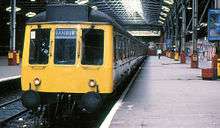
After the 1960s, lack of investment led to local services and the station becoming increasingly run down. Marylebone was the best place in London to see heritage trains. By the early 1980s, Marylebone was under serious threat of closure. In 1983 British Rail chairman Peter Parker commissioned a report into the possibility of converting Marylebone into a 'high-speed bus way', whereby Marylebone would be converted into a coach station.[37] The tracks between Marylebone, Harrow-on-the-Hill and South Ruislip would have closed, and converted into a road for the exclusive use of buses and coaches. British Rail services via High Wycombe would have been diverted into Paddington, and the Aylesbury services would have been taken over by London Underground on an extended Metropolitan line, and then routed to Baker Street.[26][38]
BR formally announced plans to close the station on 15 March 1984, pending a statutory consultation process, which began in July. Closure notices were posted at Marylebone. The proposals proved controversial and faced strong opposition from local authorities and the public, leading to a legal battle which lasted for two years.[26][38] Despite the pending closure, passenged numbers only dropped by about 400 per day from 1968 levels.[39] The conversion project proved impractical due to the headroom limitations on the line and the closure was quietly dropped.[37]
1986 onwards – revival
.jpg)
The station's fortunes turned around in the late 1980s when the station came under the control of the Network SouthEast sector of British Rail. The introduction of the inter-modal and unlimited use Capitalcard (now known as the Travelcard) led to a sharp rise in commuters into London, absorbing the spare capacity at Paddington and Baker Street and eliminating the possibility of Marylebone's services being diverted.[40]
Marylebone was reprieved from the threat of closure on 30 April 1986,[40] and an £85 million-pound modernisation and refurbishment programme of the station and its services was granted. It was funded by selling part of the station to developers, including two of the original four platforms at the west of the station and the third span of the train shed. The central cab road was removed, and two new platforms numbered 2–3 were created in its place. The run-down lines into Marylebone were modernised with new signalling and higher line speeds. In 1991, the fleet of elderly Class 115 trains on local services was replaced by Class 165 Turbo trains, and service frequencies were increased.[38] In 1993 services to Banbury were extended to the reopened Birmingham Snow Hill, creating the first long-distance service into Marylebone since 1966.[26]
Privatisation
After rail privatisation in 1996,[41] Chiltern Railways took over the rail services and developed the interurban service to Birmingham Snow Hill. The line was restored to double track in 2002, and Marylebone was expanded in 2006 with two extra platforms in Chiltern's Evergreen 2 project.[42] A new platform (platform 6) was inaugurated in May 2006,[43] while Platform 5 and the shortened platform 4 opened in September.[44] Platforms 5 & 6 were built on the site of the goods sidings and a depot was opened near Wembley Stadium railway station.[45] Some services were extended beyond Birmingham to Kidderminster.
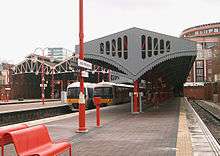
In September 2007, the Office of Rail Regulation granted the Wrexham & Shropshire Company permission to operate services from Wrexham in North Wales via Shrewsbury, Telford and the West Midlands to Marylebone; they started in early 2008, restoring direct London services to Shropshire (Wrexham already being served by a Virgin Trains service to Euston), with five return trips per day on weekdays. This was reduced to four trains a day in March 2009.[46] These services ceased on January 2011 after passenger number reduced; the closure was blamed on the Great Recession.[47]
In December 2008, it was proposed to restart direct services between Aberystwyth in mid-Wales and London, which last ran in 1991, with Marylebone as the London terminus. Arriva Trains Wales announced a consultation for two services a day, following the route of the WSMR connecting with the Cambrian line at Shrewsbury.[48] This idea was abandoned following objections by Wrexham & Shropshire.[49]
In 2011, Chiltern Railways took over the Oxford to Bicester Town route from First Great Western, in preparation for the opening of a link from the Chiltern Main Line to the Varsity Line (on which Bicester Town station is located), which would see twice-hourly services from Marylebone to Oxford. Construction was expected to start in 2011 but was delayed until the following year after bats were found roosting in one of the tunnels on the Varsity line. Services to Oxford Parkway started in October 2015, with services to Oxford expected to start on 12 December 2016.[50][51]
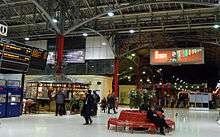
Services
Monday-Friday (off-peak)
- 2 trains per hour (tph) to/from Birmingham (one fast, first stop Bicester North, and one semi-fast, first stop High Wycombe).
- 1tph to/from Banbury (semi-fast, first stop High Wycombe). Some extend to Stratford-upon-Avon.
- 1tph to/from Bicester North (semi-fast, first stop Gerrards Cross)
- 1tph to/from Princes Risborough (semi-fast, first stop Gerrards Cross)
- 1tph to/from High Wycombe (stopping service)
- 1tph to/from Gerrards Cross (stopping service)
- 2tph to/from Aylesbury (via Amersham). One of these services in each hour continues on to serve Aylesbury Vale Parkway
- 2tph to/from Oxford Parkway (fast). From 12 December 2016, this will be extended to Oxford.[52]
Additional services run in the peak hours, and some Birmingham trains extend to Kidderminster or Stourbridge Junction. In the evenings there are direct services to Aylesbury via High Wycombe.
| Preceding station | |
Following station | ||
|---|---|---|---|---|
| Gerrards Cross | Chiltern Railways Chiltern Main Line semi-fast services |
Terminus | ||
| Harrow-on-the-Hill | Chiltern Railways London to Aylesbury Line |
|||
| Wembley Stadium | Chiltern Railways London – High Wycombe stopping services |
|||
| High Wycombe or Bicester North or Banbury |
Chiltern Railways Chiltern Main Line fast services |
Terminus | ||
| Historical railways | ||||
| Harrow-on-the-Hill Line and station open |
Great Central Railway Great Central Main Line |
Terminus | ||
Locomotive servicing facilities
The GCR constructed an engine shed at the site in 1897, which did not survive for long. A locomotive servicing area, consisting of a turntable and coaling stage remained in use until the end of steam traction at the station in 1966.[53] The area was allocated the shed code 14F until 1963, then 1D. The turntable remained in situ until the mid-1980s.
Station facilities
The station opened with a dining restaurant and a buffet. The restaurant was changed to a self-service operation when British Rail took over in 1948.[32] The Victoria and Albert bar opened on 14 December 1971.[39] In the 21st century, the concourse contains a small selection of shops.[54]
Accidents
On 28 March 1913, a train leaving for High Wycombe collided with another arriving from Leicester, killing one passenger and injuring 23 people on the incoming train. The cause was blamed on the intermediate starter signal being lowered before the main starter was ready; the view of the latter was obscured by the smoke.[55]
On 11 December 2015, a train pulling into the station caught fire, causing it to be evacuated. The cause was believed to be a fault in its air conditioning unit.[56]
London Underground
| Marylebone | |
|---|---|
|
Bakerloo line platform | |
| Location | Marylebone |
| Local authority | City of Westminster |
| Managed by | London Underground |
| Number of platforms | 2 |
| Fare zone | 1 |
| London Underground annual entry and exit | |
| 2012 |
|
| 2013 |
|
| 2014 |
|
| 2015 |
|
| Key dates | |
| 1907 | Opened as temporary terminus (BS&WR) |
| 1907 | Service extended (BS&WR) |
| Other information | |
| Lists of stations | |
|
| |
The London Underground station is on the Bakerloo line between Baker Street and Edgware Road stations and is, along with the main line station, in Travelcard Zone 1.[58] Access is via escalators from the main line station concourse which houses the Underground station's ticket office. Until 2004 a wooden escalator led into the station, one of the last on the London Underground system that had not been replaced.[59]
Marylebone has direct connections with just a single tube line, unlike many other London termini such as Euston and Paddington.[58] There is no direct interchange with the Circle line, which predates the station by more than 30 years and bypasses it to the south.[60] The station is a short walk from Edgware Road (Circle line) and Baker Street stations.
History
The underground station was opened on 27 March 1907 by the Baker Street and Waterloo Railway under the name Great Central (following a change from its intended name Lisson Grove).[61] The railway terminated here until the extension to Edgware Road opened on 15 June.[62] The station was renamed Marylebone on 15 April 1917.[63] The original name still appears in places on the platform wall tiling, although the tiling scheme is a replacement designed to reflect the original scheme.[64]
 |
Riding the up escalator
Riding the up escalator from the underground station to the main concourse. The beeps near the end are Oyster cards being swiped. |
| Problems playing this file? See media help. | |
The present entrance opened on 1 February 1943 following wartime damage to the original station building that stood to the west at the junction of Harewood Avenue and Harewood Row and the introduction of the escalators.[28] The old building, designed by the Underground Electric Railways Company of London's architect, Leslie Green, had used lifts to access the platforms. It was demolished in 1971 and the site is occupied by a budget hotel.
| Preceding station | Following station | |||
|---|---|---|---|---|
towards Harrow & Wealdstone | Bakerloo line | towards Elephant & Castle |
Gallery
-
Northbound Bakerloo line platform looking south
-
Southbound Bakerloo line platform looking north
-
Roundel on southbound Bakerloo line platform
-
Decorative tiling revealing the original name of the Bakerloo line station, Great Central. Northbound platform only.
Cultural references
As one of the quietest London terminals, Marylebone has been popular as a filming location.[65] In 1964 several scenes in The Beatles film A Hard Day's Night were filmed here, as was the opening scene of the 1965 film of The IPCRESS File.[26] It appeared in an episode of Magnum, P.I. when the series was filmed around London.[66] Marylebone station doubled for Charing Cross in the 1974 episode of Upstairs Downstairs – Women Shall Not Weep.[67] In ITV's The Upchat line (1977), Mike Upchat (played by John Alderton), a writer who lives out of a locker on Marylebone station, has the rare ability to become any character that best fits the situation.[68] The station appeared in the BBC's spy drama Spooks (Season 4, Episode 1), standing in for Paddington.[66] and the Doctor Who serial, Doctor Who and the Silurians.[69]
Marylebone is one of four stations on the British version of the Monopoly board game, along with King's Cross, Fenchurch Street and Liverpool Street. The four stations were all LNER termini at the time the board was designed in the mid-1930s.[70]
See also
- The Landmark London – the present name of the former Great Central Hotel
References
Citations
- ↑ "London and South East" (PDF). National Rail Enquiries. National Rail. September 2006. Archived from the original (pdf) on 6 March 2009.
- 1 2 3 4 5 6 "Station usage estimates". Rail statistics. Office of Rail Regulation. Please note: Some methodology may vary year on year.
- ↑ "Station facilities for London Marylebone". National Rail Enquiries. Retrieved 29 May 2013.
- ↑ Cole 2011, p. 162
- ↑ "Marylebone Station". Google Maps. Retrieved 29 November 2016.
- ↑ "Marylebone Station". Chiltern Railways. Retrieved 19 November 2016.
- ↑ Jackson 1984, p. 331.
- 1 2 Jackson 1984, p. 332.
- ↑ Jackson 1984, p. 333.
- ↑ Jackson 1984, p. 334.
- 1 2 McCarthy & McCarthy 2009, p. 74
- ↑ Butt 1995, p. 156
- ↑ Dow 1962, p. 340
- 1 2 Christopher 2015, p. 48
- 1 2 Simmons & Biddle 1997, p. 189.
- ↑ Braddock was the son of a stone carver from Bolton, Lancashire. As a civil engineer he had been employed on the Mersey railway tunnel, but returned to London, where he had been living with his wife Selina, following completion of the project. His son was Tom Braddock (1887–1976), Labour M.P. Palgrave, p. 23
- ↑ The terminus was described and illustrated by G. A. Hobson and E. Wragge in "The Metropolitan Terminus of the Great Central Railway", Minutes of the Proceedings 143 (1901.1) pp 84ff; the volume also contains a round-robin discussion of the terminus, in which Braddock was not included.
- 1 2 Weinreb et al 2008, p. 535
- 1 2 Jackson 1984, p. 335.
- ↑ Dow 1962, p. 409
- 1 2 Dow 1962, p. 287
- ↑ Weinreb et al 2008, pp. 534–535,797
- ↑ Dow 1962, p. 328
- ↑ Jackson 1984, p. 336.
- ↑ Simmons & Biddle 1997, p. 291.
- 1 2 3 4 5 6 7 Lambert, Anthony J. (1999). 1899–1999 Marylebone Centenary. London: Metro. OCLC 841865579.
- ↑ Jackson 1984, pp. 338–9.
- 1 2 3 Jackson 1984, p. 340.
- 1 2 3 4 Sanders, Shawn (n.d.). "London Extension 1899–1969". The Great Central Railway.
- ↑ Riddaway & Upsall 2015, p. 276.
- 1 2 Jackson 1984, p. 341.
- 1 2 3 4 Jackson 1984, p. 342.
- ↑ "Revision of Regional Boundaries of British Railways". The Railway Magazine. London. 96 (587): 201–4. March 1950.
- ↑ Jackson 1984, pp. 342,370.
- ↑ Jackson 1984, p. 370.
- ↑ Haywood 2016, p. 211.
- 1 2 Haywood 2016, p. 189.
- 1 2 3 "Almost Terminal: Marylebone's Brush With Destruction". London Reconnections. 20 February 2014. Retrieved 15 September 2015.
- 1 2 Jackson 1984, p. 371.
- 1 2 "Marylebone Station Celebrating 30 Years Since Threatened Closure" (PDF). St Marylebone Society. Summer 2014. Retrieved 21 November 2016.
- ↑ http://www.atoc-comms.org/franchised-passenger-services-chiltern-railways.php
- ↑ "£250m Rail Investment to Slash Journey Times and Create New Oxford-London Route". Network Rail Media Centre. 15 January 2010. Retrieved 27 November 2016.
- ↑ "Job completed!" (PDF). The Railway Consultancy. June 2006: 2. Retrieved 30 November 2016.
- ↑ "Marylebone Railway Station". LondonTown. Retrieved 28 November 2016.
- ↑ Network Rail 2006, pp. 4–5.
- ↑ "WSMR cuts service". Modern Railways. London. April 2009. p. 6.
- ↑ "Wrexham-Shropshire-London direct rail link to end". BBC News. 26 January 2011. Retrieved 27 November 2016.
- ↑ "Aber-London rail link may reopen". BBC News Online. 19 December 2008. Retrieved 2 January 2009.
- ↑ "Aberystwyth to London direct rail route rejected". BBC News Online. London. 1 March 2010. Retrieved 1 March 2010.
- ↑ "New £320m Oxford to London Marylebone rail line opens". BBC News. 26 October 2016. Retrieved 29 November 2016.
- ↑ "Next stop central Oxford – open from 12.12.2016". Chiltern Railways. Retrieved 29 November 2016.
- ↑ "NR lays down Oxford tracks ahead of London Marylebone service in December".
- ↑ Griffiths & Smith 1999, p. 81
- ↑ "National Rail - London Marylebone station plan".
- ↑ Jackson 1984, p. 344.
- ↑ "London Marylebone Station closed after train fire". BBC News. 11 December 2015. Retrieved 28 November 2016.
- 1 2 3 4 "Multi-year station entry-and-exit figures" (XLS). London Underground station passenger usage data. Transport for London. April 2016. Retrieved 3 May 2016.
- 1 2 "Tube Map" (PDF). TfL. Retrieved 19 November 2016.
- ↑ Platt, Geoff (2015). The London Underground Serial Killer. Wharncliffe. p. 54. ISBN 978-1-473-85829-9.
- ↑ Demuth 2004, pp. 2,12.
- ↑ Day 1979, pp. 72,75
- ↑ Demuth 2004, p. 12.
- ↑ Rose, Douglas (1999). The London Underground, A Diagrammatic History. Douglas Rose/Capital Transport. ISBN 1-85414-219-4.
- ↑ Rose, Douglas. "Great Central". London's Underground Edwardian Tile Patterns. Retrieved 13 January 2008.
- ↑ Moore 2003, p. 161.
- 1 2 "Location of the Month 2007 August 2007 – Marylebone Station". Film London. Retrieved 11 March 2013.
- ↑ "Upstairs Downstairs fact file". Retrieved 3 November 2013.
- ↑ British Comedy Guide.
- ↑ "Marylebone Station – The Locations Guide to Doctor Who, Torchwood and The Sarah Jane Adventures". The Locations Guide to Doctor Who, Torchwood, and the Sarah Jane Adventures.
- ↑ Moore 2003, pp. 158–9
Sources
- Butt, R.V.J. (1995). The Directory of Railway Stations. Yeovil: Patrick Stephens Ltd. ISBN 1-85260-508-1. R508.
- Cole, Beverly (2011). Trains. Potsdam, Germany: H.F.Ullmann. ISBN 978-3-8480-0516-1.
- Christopher, John (2015). London's Historic Railway Stations Through Time. Amberley Publishing. ISBN 978-1-445-65111-8.
- Day, John R. (1979) [1963]. The Story of London's Underground (6th ed.). Westminster: London Transport. ISBN 0-85329-094-6. 1178/211RP/5M(A).
- Demuth, Tim (2004). The Spread of London's Underground. Capital Transport Publishing. ISBN 1-85414-277-1.
- Dow, George (1962). Great Central, Volume Two: Dominion of Watkin, 1864–1899. Shepperton: Ian Allan. ISBN 0-7110-1469-8.
- Haywood, Russell (2016). Railways, Urban Development and Town Planning in Britain: 1948–2008. Routledge. ISBN 978-1-317-07164-8.
- Griffiths, Roger; Smith, Paul (1999). The directory of British engine sheds 1. Oxford Publishing Co. p. 91. ISBN 0-86093-542-6.
- Jackson, Alan A. (1984) [1969]. London's Termini. London: David & Charles. ISBN 0-330-02747-6.
- McCarthy, Colin; McCarthy, David (2009). Railways of Britain – London North of the Thames. Hersham, Surrey: Ian Allan Publishing. p. 74. ISBN 978-0-7110-3346-7.
- Moore, Tim (2003). Do Not Pass Go. Random House. ISBN 978-1-409-02216-9.
- Riddaway, Mark; Upsall, Carl (2015). Marylebone Lives: Rogues, romantics and rebels – character studies of locals since the eighteenth century. Spiramus Press Ltd. ISBN 978-1-910-15103-7.
- Simmons, Jack; Biddle, Gordon (1997). The Oxford Companion to British Railway History. Oxford University Press. ISBN 978-019-211697-0.
- Weinreb, Ben; Hibbert, Christopher; Keay, Julia; Keay, John (2008). The London Encyclopedia. Pan MacMillan. ISBN 978-1-4050-4924-5.
- Business Plan 2006 – Route 16: Chilterns (PDF) (Report). Network Rail. 2006. Retrieved 29 November 2016.
External links
| Wikimedia Commons has media related to Marylebone station. |
- Train times and station information for Marylebone station from National Rail
- Marylebone Station at Chiltern Railways
